The best ways to dry blackcurrants at home
Children and adults love currants - they are one of the healthiest and most delicious berries from the garden. However, its ripening period is short - fresh currants can only be consumed for a few weeks. For this reason, various methods of harvesting this berry are so popular. One of the most common is canning, but with such processing the taste and nutrients are lost. As an alternative, drying black currants is used.
In this article we will tell you how to dry blackcurrants at home, what to pay attention to during its storage and how to use harvested berries.
Is it possible to dry blackcurrants?
When canning, due to heat treatment, most of the beneficial compounds in fruits and berries are destroyed. And this deficiency is especially obvious when preparing vitamin-rich berries, which include black currants.
This is interesting! Currant was known in Rus' in ancient times and was considered a healing berry.
Preservation is not the only way to preserve currants for the winter. Drying is much gentler than cooking, and helps preserve more of the vitamins and nutrients of the berry, as well as its taste and aroma.
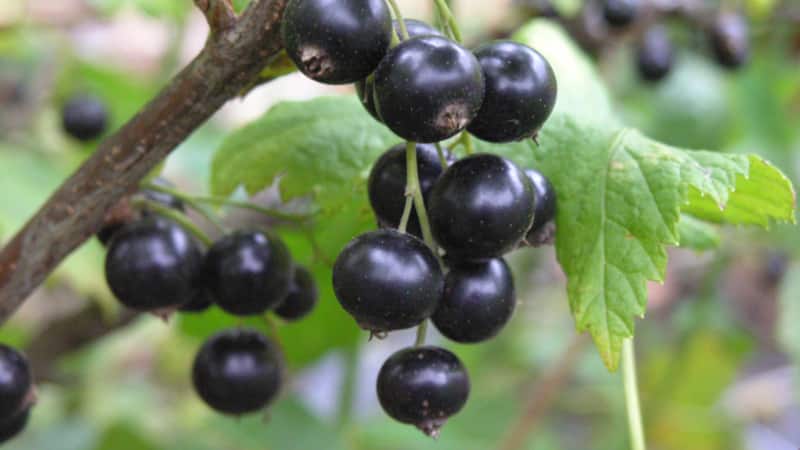
Preparing currants for drying
Although drying cannot be called a complex process, it requires compliance with certain rules, first of all, preliminary preparation of the product.
Currants are picked on a sunny day, since wet berries are much worse stored.Only fully ripe berries are selected and diseased and rotten ones are disposed of. They can infect others and impair the taste of the product. Currants picked with tassels are suitable for drying.
After picking, the currants are washed and left to dry. It is better to lay it on a soft towel so that it absorbs moisture.
How to properly dry blackcurrants
The water content in currants is about 85-90%. In order for it to be called dried, this figure must be reduced to 15%. It is important to ensure that it does not become smaller. Overdried currants lose their taste and benefits for the body.
There are many ways to dry blackcurrants. Some require only sun and air, others require special devices. Drying conditions and times vary.
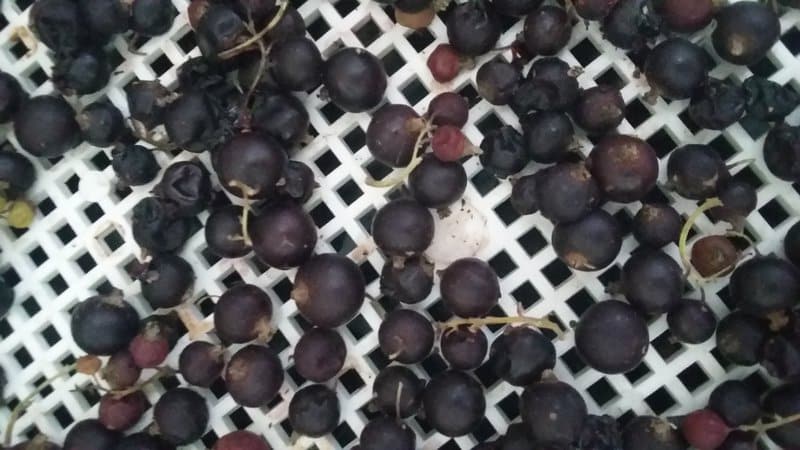
On air
This drying method is the most ancient of all. Due to its simplicity, many gardeners dry currants this way.
It is best to dry berries using wooden trays or pallets. If you place them on metal, it will give the workpieces an unpleasant aftertaste. The surface is covered with tracing paper or parchment and the currants are spread over the paper in an even, thin layer. It is important to ensure that it does not lie crowded, otherwise drying will be uneven.
After this, cover the currants with gauze and take the trays out to the balcony or attic. From time to time, check it and turn it a little to avoid damage and uneven drying.
Drying takes on average 2 days. After the moisture from the berries has evaporated, it is recommended to leave them in the oven at a temperature of +55°C for 5-6 hours. Then the harvested crop is placed in glass or ceramic containers for winter storage.
This combined method is used to preserve the maximum amount of vitamins in dried berries.
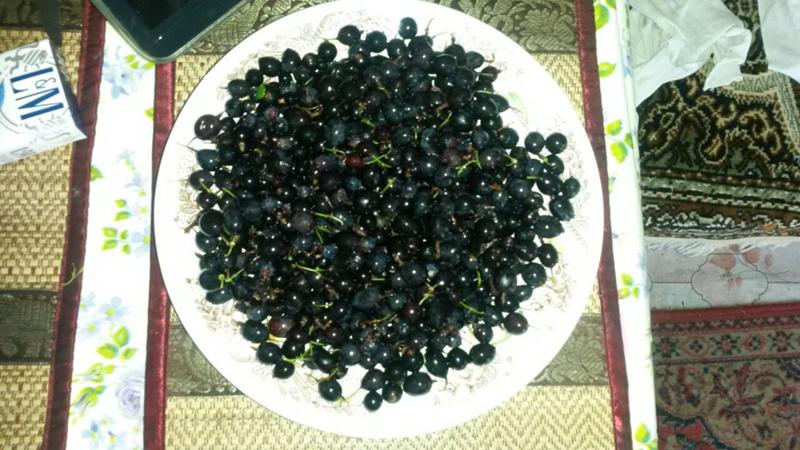
Sun drying
Drying currants in the sun is the same ancient and simple method as harvesting them in the air.
For this drying you will need:
- Line a wooden tray or tray with parchment paper (baking paper) or tracing paper.
- Sprinkle the currants evenly onto the paper in one layer.
- First place the container with berries in the shade, and when some of the moisture has evaporated, move it to the sun. At the hottest time of the day, remove the berries under a canopy.
- To prevent flies, bees, wasps and other insects from spoiling the berries, cover the trays with gauze or thin cotton cloth.
- To avoid spoilage of the berries and uneven drying, the currants are periodically stirred, making sure that they are evenly distributed on the surface.
Harvesting in the sun takes about 2 days. After this, the sun-dried berries are dried in the oven for about 5 hours.
Important! Direct sunlight has a detrimental effect on the content of vitamin C, which is destroyed in the sun. Therefore, it is recommended to combine preparation in the sun with other methods, for example, drying in an oven or microwave.
Oven
Preparing currants in the oven is the most popular drying method. It is simple and allows you to dry the berries much faster and better, in the air and sun.
Before drying in the oven, the currants are sorted out, all spoiled and damaged berries are sorted, washed and dried from water in the open air.
How to make a blank:
- Line a baking sheet with baking parchment (preferably in 2 layers) or aluminum foil.
- Spread the berries evenly over the coating in one layer.
- Set the oven temperature to +45°C and place the currants there for 1 hour. At this stage, the berries should wilt a little.
- Remove the berries and let them cool. At the same time, increase the temperature to +70°C.
- Place the cooled currants back into the oven and dry for about 2 hours until tender.
The finished product is stored. When drying, never set the temperature to high immediately. Because of this, a crust forms on the currants, which will prevent the evaporation of moisture.
Important! When drying, take into account the size of the berries. If the currants are large, they are kept for about 3 hours.
Microwave
You can quickly dry berries using the microwave. Currants prepared in this way turn out beautiful, bright and tasty. However, the microwave will only help if there are only a few berries. Coping with the whole harvest she won't be able to.
Cover a plate from the microwave with a cotton cloth or napkin and pour the sorted berries evenly onto it. It is important to ensure that they lie in one layer. They are covered with another napkin on top.
The prepared currants are placed in the oven and the power is set to 200 W. Warm up for 5 minutes. After this, turn off the microwave and check the dried berries for readiness. If necessary, you can dry them several more times, checking and stirring the berries every 30 seconds.
Electric dryer
An electric dryer is a device specially designed for preparing dried fruits. It is suitable for gardeners who prefer not to preserve fruits and berries, but to dry them.
To dry currants in an electric dryer, set the temperature to no more than +50...+55°C. At higher temperatures, the berries will become crusty.
The currants are sorted, washed and air dried.After this, it is evenly laid out in one layer on the pallets of the electric dryer. The spread out berries are left for 10 minutes, and then the trays are placed in the dryer.
After this, just check the berries and stir lightly. The drying process takes 50 hours from the moment the currants are placed in the dryer.
Checking the readiness of currants
During the drying process, the appearance of the berries changes. At the initial stage they acquire a brownish-burgundy color, after which it changes to dark red. But only when the currants begin to wrinkle and turn black are they checked for readiness.
When checking, shake the berries. Larger ones may not be ready yet and will spoil during storage, and remove all the rest. When all the currants acquire a black and burgundy color, wrinkle and have a slight peculiar smell, the berries are cooled and placed in a special container for storage.
How to store dried currants
When storing, follow a number of rules:
- dried berries are stored in a dark place, since direct sunlight destroys the vitamin C and other beneficial microelements they contain;
- glass containers or ceramic dishes are used for storage;
- keep currants in a container with a tight-fitting lid to avoid moisture;
- The storage room is warm and dry.
It is not recommended to store the product in iron cans - in less than a month, all the berries will be saturated with a characteristic iron taste, and the product will be spoiled. If you don't have the necessary utensils, even tightly sealed cardboard boxes are suitable.
Important! Before storing currants, be sure to let them cool to room temperature.If you pack the berries while they are still hot, they will produce condensation, which promotes the development of mold.
How to use dried berries
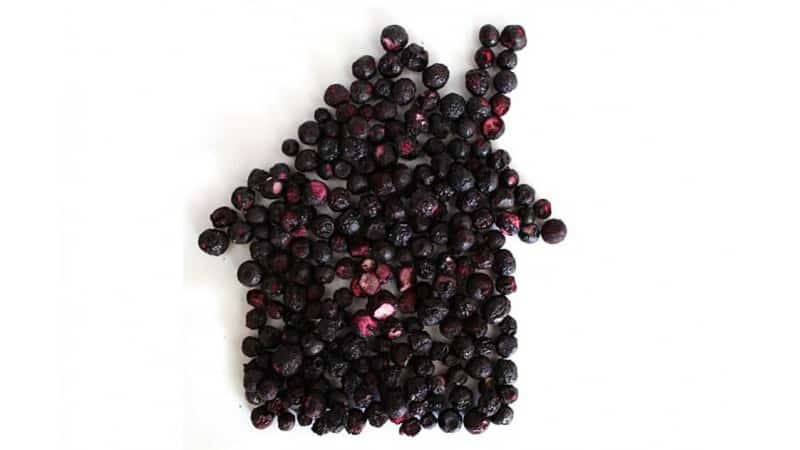
Dried currants have even more uses than fresh ones. For example, it is added to kvass to improve its taste, and birch sap is fermented with its help, making it naturally carbonated. Various homemade tinctures and liqueurs are prepared with it.
The healing properties of currants do not disappear even after drying. This berry has antiviral properties, prevents colds and works as an antipyretic. Decoctions and teas are prepared from dried currants, which alleviate the course of the disease. These drinks can be consumed by healthy people as a preventive measure or just because they are tasty and aromatic.
Dried currants are used not only for teas and decoctions. It is suitable for compotes and fruit drinks as the only ingredient or as part of a recipe.
Some housewives chop and use this berry as a seasoning for dishes or as an addition to baked goods. It can be added instead of raisins to cheesecakes. Dried currants are even suitable for puddings and ice cream.
Drying currant leaves
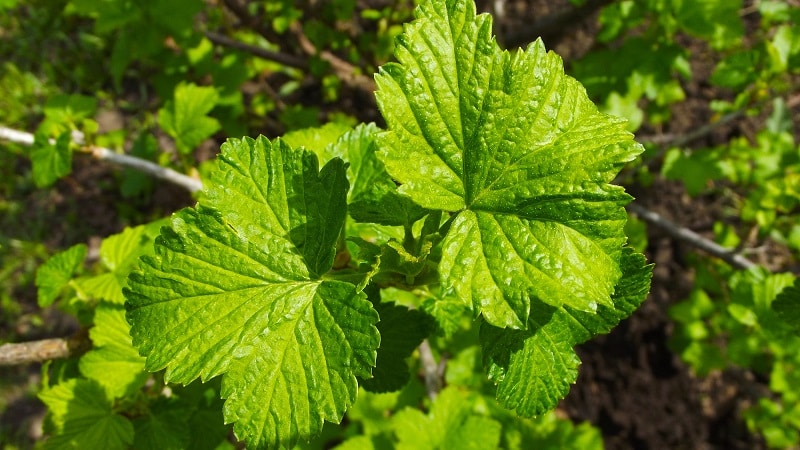
Harvesting currants is not limited to berries alone. Very popular and leaves this plant. They are added to tea, resulting in a delicious drink with a pleasant aroma. That is why many gardeners dry them for the winter.
Currant tea is not only tasty, but also has medicinal properties. This drink fights colds, which many suffer with the onset of autumn and winter cold.This tea is also used to prevent diseases; it maintains the required level of vitamins and nutrients in the body.
Important! Currant leaves, despite their usefulness, have contraindications. They should not be added to tea for those who suffer from ulcers or high acidity of the gastrointestinal tract.
Currant leaves are collected early in the morning or evening in clear weather. Wet leaves quickly deteriorate, so in case of rain you should wait until the moisture evaporates from them. Leaves that grow in the middle of the branch are suitable for drying.
The collected leaves are sorted, getting rid of those damaged by insects or diseases. After this, they are laid out on white paper or cotton cloth in a dry place with access to air. The leaves should lie in one layer, without overlapping each other.
Currant leaves are placed in bags or paper bags only after they are completely dry. This is checked by breaking one of them. If the leaf crumbles easily, this means that it is completely ready for storage and use.
Often, currant leaves are dried not in air, but using an electric dryer. This speeds up the process.
The preparation of currant leaves is not limited to classical drying. Besides this, there is another way - fermentation. It is not so popular, but very effective.
Leaves are fermented as follows:
- The collected leaves are placed in a dark room for 24 hours, stirring them from time to time.
- After a day of resting, the leaves are rolled up into tubes and waited until they begin to secrete juice.
- The tubes are placed in glass containers, covered with a damp natural cloth and moved to a warm place. Periodically check the fabric and moisten it with water if it is dry.
- The leaves are fermented until they give off a strong sweet aroma. After this they are dried.
- To dry, the leaves are cut, laid out on a baking sheet and placed in an oven preheated to a temperature of +70°C. Drying takes 1 hour.
Dried leaves are stored in a dark and dry place. To do this, use tightly closed glass or ceramic containers.
Conclusion
Black currant is one of the healthiest berries in the garden. Although its fruiting season is short, you can enjoy the berry at any time if you prepare it correctly. Drying currants is a fairly simple and effortless process. Thanks to drying, beneficial substances and vitamins are preserved, which are destroyed during preservation.
If you follow all the rules of preparation and storage, you can delight yourself with a variety of dishes and drinks with this tasty and healing berry all year round.